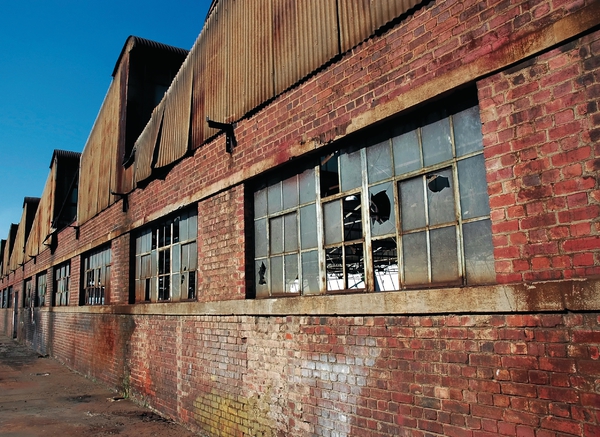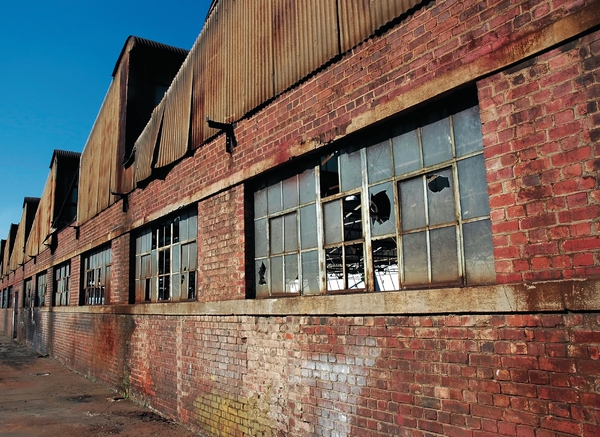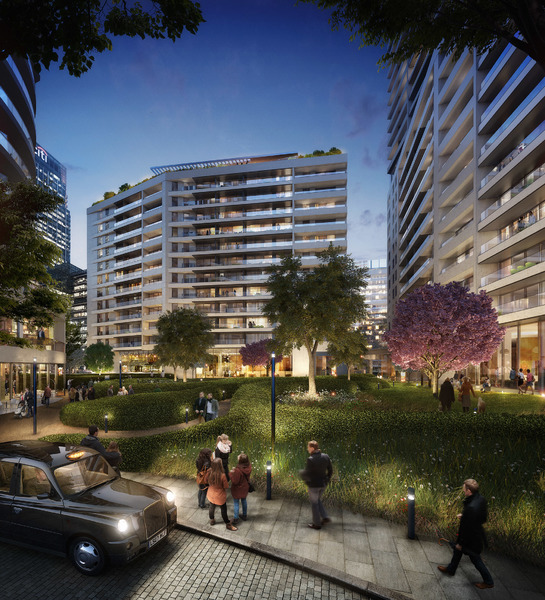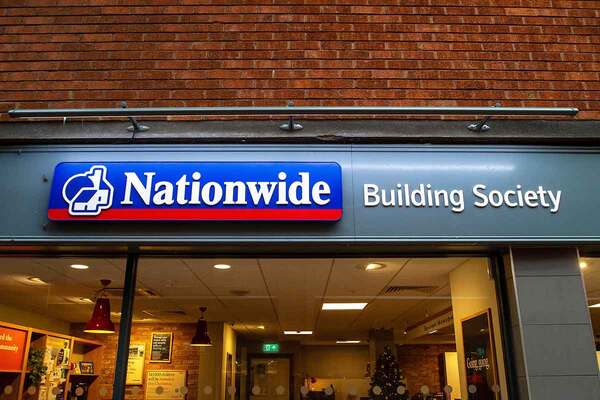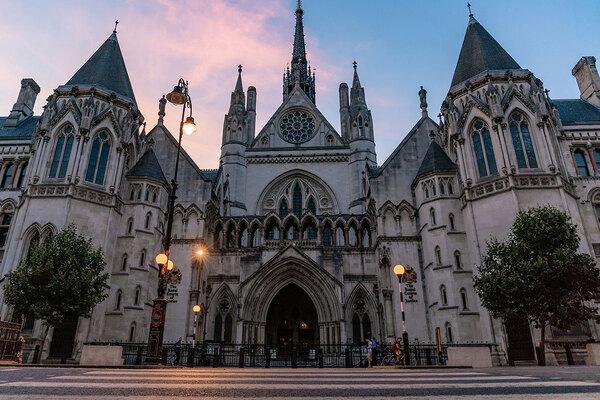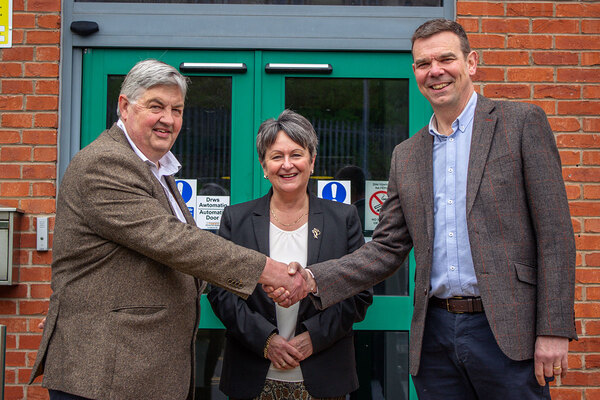You are viewing 1 of your 1 free articles
Field day
Building on brownfield is the preference of the new government, but how viable is it? Mark Wilding reports on the practicalities and the possibilities
Video:
feature style

Does brownfield land represent a challenge or a fresh shoot of hope for housebuilding? Building on previously developed land offers a populist approach to tackling the housing crisis, swerving the potential controversies stirred up by greenfield plans. But it also brings with it some of the greatest obstacles to housing delivery: difficult sites, complex planning negotiations and lack of funding.
In the run-up to the 2015 general election, the Conservatives decided it was time for an opportunity to knock again for brownfield. Announcing the party’s manifesto, David Cameron outlined his priorities. ‘We will ensure that brownfield land is used as much as possible for new development,’ he said.
While work had been going on to prioritise the use of brownfield sites under the coalition, it was clear that the Conservatives would be pushing this agenda much harder in a bid to boost housing supply while satisfying its core countryside vote that the country’s green belt would go undisturbed.
Video:
Ad slot
While the rhetoric was about the opportunity, the Conservatives know only too well that some serious measures will be required to tackle the challenges. To this end, a suite of policies have been drawn up (see box). These can broadly be seen as a three-pronged approach: identifying land, smoothing the way through planning, and providing funding. But question marks remain. How much brownfield land is available? To what extent is it suitable for development? And do local authorities have the capacity to fulfil their role in opening it up for building?
Site potential
“If this approach is carried through, much of what the public might regard as ‘brownfield’ would not appear on land registers.”
Tim Pugh, partner in the planning and environment practice, Berwin Leighton Paisner
The first challenge lies in identifying how much potential brownfield sites really offer. A government consultation published in January stated that ‘brownfield land could accommodate up to 200,000 homes’. Mr Cameron then said that a proposed brownfield fund could support the construction of up to 400,000 homes. Meanwhile, the Campaign to Protect Rural England claims that ‘local authorities have identified the capacity for at least one million homes on suitable brownfield land in England’.
Clearly, the picture is confused. To this end, the Conservatives’ manifesto called for local authorities to publish regular data on the number of brownfield sites in their area and their potential for development. A consultation published earlier this year under the coalition, Building More Homes on Brownfield Land, suggests this would have to be updated annually but does not propose a date at which this requirement would be implemented.
But this is just the first step, to be followed by the much more difficult challenge of ensuring they go on to be developed. In the consultation paper, the last government outlined plans for councils to grant local development orders, an advanced form of planning permission, on 90% of suitable brownfield sites by 2020.
The key word is ‘suitable’. By the government’s own definition, sites must be deliverable, free of constraint, capable of development and of supporting five or more dwellings. Tim Pugh, partner in the planning and environment practice at law firm Berwin Leighton Paisner, suggests that when assessed against these criteria, many sites would not make the cut. ‘If this approach is carried through, much of what the public might regard as “brownfield” would not appear on land registers,’ he says. ‘This could mean that some desirable brownfield sites are excluded but, more likely, that unviable sites are immediately taken out of the equation.’
Site location is another factor, which becomes particularly relevant outside London and the south-east. ‘In some places, the maths simply will not work,’ says Mr Pugh. ‘It is important that the government does not allow its intentions to register available surplus public sector land to morph into a “brownfield land” register simply to match electioneering soundbites.’
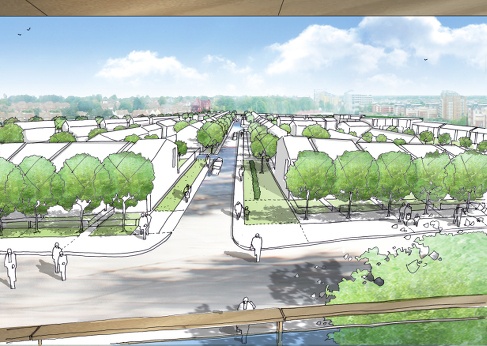
Artist’s impression of the brownfield development at Chapel Hill
Brownfield examples
Although it can be difficult, some social landlords are building on brownfield successfully.
Consider the site of a former pharmaceutical production plant and timber yard in Basingstoke, which is going to be transformed into a 576-home development in a joint venture between 9,100-home Sentinel Housing Association and house builder Barratt David Wilson. The social landlord bought the redundant 25.6-acre brownfield site on Chapel Hill in 2012, achieved outline planning permission last year and work is under way to obtain detailed planning permission.
The site is not heavily contaminated, but the association has agreed a remediation plan with the local authority to clean up localised areas of contamination.
Mark Perry, chief executive of Sentinel Housing Association, says the organisation has provided in excess of 1,000 new homes through regeneration and brownfield site projects, and invested more than £200m in the last 10 years. ‘Brownfield sites will continue to form a significant part of our strategy for the delivery of new homes,’ he adds.
Possible outcomes
Local authorities and planning officers have also questioned the likely impact of such a target. Responding to the government’s consultation, the Local Government Association suggested that sites meeting the proposed criteria would already be allocated for development in local plans. The Planning Officers Society (POS) said such a policy would require the National Planning Policy Framework to be rewritten.
Others have questioned whether over-stretched planning departments will have the capacity to implement a regime of advanced planning permissions. Sarah Davis, senior policy and practice officer at the Chartered Institute of Housing, says: ‘The planning system is really critical in terms of delivery and this is happening at a time when there’s a lot of pressure on local authorities.’
However planning is secured, viability is another key issue. The need to demolish existing structures and deal with site contamination can result in abnormally high costs on brownfield sites. To this end, proceeds from the sale of high-value council properties will be used to create a brownfield regeneration fund that councils can use to prepare sites for development.
Housing Zones form another key part of the government’s strategy. Developers, including housing associations, can bid for Housing Zone status, which opens up a wide range of possible assistance in the form of both funding and planning measures. The zones have already been used to significant effect in London. The 21,000-home Catalyst Housing Group secured funding to build 4,345 homes on the Havelock Estate, of which 1,785 will be affordable.
The Havelock Estate is part of the Southall Housing Zone, which received £20.1m of funding from the Greater London Authority. Peabody, which manages 27,000 homes in London, said Housing Zone status at Thamesmead, where it is working with the London boroughs of Greenwich and Bexley, will allow it to develop 2,300 more homes than initially planned.
Dan Hill, head of Thamesmead strategy at Peabody, says the flexibility provided by a mix of loans and grant funding, plus the impetus for various parties to work together on things such as infrastructure, has proved hugely beneficial. ‘I think they have got quite a lot of potential,’ he says.
Outside London
It remains to be seen whether the Housing Zone model can be successfully replicated outside London. A Royal Institution of Chartered Surveyors report published in March this year found numerous constraints on brownfield development, including land ownership and planning negotiations. Site contamination was another frequently cited factor. But the most frequently occurring constraint the researchers found was poor market conditions. In London, houses built almost anywhere will find a buyer or a tenant. Elsewhere, viability issues could affect affordable housing contributions.
Andrew Drury, managing director at affordable housing consultancy HATC, says: ‘Any private house builder would use that to reduce any planning obligation that they would otherwise have to offer.’
It will fall upon local authorities to ensure a reasonable contribution. But viability assessments are always complex, and brownfield sites make them even more so. A combination of subsidies, land contributions, abnormal site costs and tax relief makes it all much harder to ensure best value for the public purse and an adequate affordable housing contribution. Once again, the success of the government’s brownfield strategy will largely rely on the capacity of local authority planning teams.
With all these challenges taken into account, the size of the opportunity offered by brownfield development looks in considerable doubt. Every contribution to the UK’s housing shortfall helps, but will brownfield sites contribute more than a drop in the ocean?
Mr Drury has doubts: ‘We need to retain focus, look past this initiative and see it in the broader context of the contribution it will make towards the overall housing need. If it’s only a modest contribution, the conversation then moves on to: “What else are we going to do?”’
Brownfield policies
Brownfield regeneration fund
The expansion of Right to Buy to housing association tenants was accompanied by a promise that the proceeds would be used to create a £1bn brownfield regeneration fund.
The Conservatives say local authorities selling off properties will be expected to replace homes on a one-to-one basis, but also to prepare additional brownfield sites for development.
David Cameron has suggested the fund could pave the way for 400,000 new homes.
Brownfield register
The Conservative manifesto states: ‘We will require local authorities to have a register of what is available,’ while a pre-election consultation paper on using brownfield land suggests that councils could be asked to publish an annual list of brownfield sites, including their size and details of planning and ownership status.
In London, a land commission has been established to identify publicly owned brownfield land with a view to developing every site by 2025.
Planning targets
To smooth out any obstacles to development, the government has said it will ‘ensure that 90% of suitable brownfield sites have planning permission for housing by 2020’. This will involve the use of local development orders, which councils can use to grant permission for certain types of development.
This target could also be phased, with any authorities falling behind on their targets subject to ‘designation’ and central government taking on planning responsibilities.
Housing Zones
Housing Zones have already been introduced in London. The Conservative manifesto suggests a wider roll-out could lead to the development of 95,000 homes. Developers must provide a mix of open market, market rent and affordable housing - in return, they are eligible for a wide range of support through both planning and financial measures.
These include certainty on planning timescales, clarity over section 106 obligations, contributions a developer agrees to make to a local authority in exchange for planning permission, upfront funding for site remediation, Greater London Authority funding for affordable housing and public land contributions.
Typically, the zones will last for 10 years and will be expected to deliver between 1,000 and 2,500 homes.
